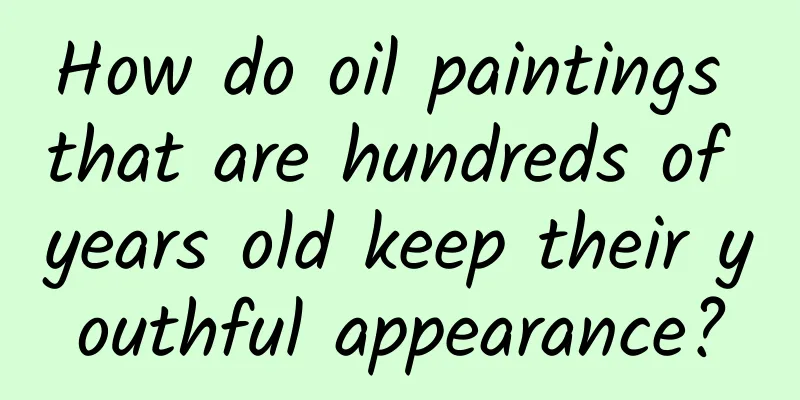How do oil paintings that are hundreds of years old keep their youthful appearance?

|
On May 18th every year, most museums around the world hold themed events. For example, the theme of China's "International Museum Day" in 2019 is "Museums as Cultural Hubs: The Future of Tradition". (Quick test: Which museum in China do you think will be the main venue when you see this theme?) However, due to the impact of the COVID-19 epidemic in recent years, many museums have been closed from time to time, but this is not entirely a bad thing. For example, you can take out the museum's oil paintings during this period and repair them. What happened to oil painting? As a painting method that really appeared during the Renaissance, oil painting has a history of only a few hundred years, but because oil paint does not change color after drying and can perfectly blend a variety of different colors to create a stronger sense of layering, oil painting has gradually become the main painting method in the history of Western painting. Oil painting was introduced to China in the last century. After nearly a century of development, Chinese oil painting art has made great progress in both painting techniques and styles. However, perhaps during this period, the early development was focused on, and the later restoration and preservation technology did not keep up, resulting in the state of many precious oil paintings that can only be described in one word: dangerous! In contrast, although the development history of Western oil paintings is longer than that of China, the oil paintings exhibited in major museums and art galleries are still relatively well preserved. What does it feel like? Western oil paintings are 400 years old, and Chinese oil paintings are 100 years old, but when the two are compared, it seems that the ages of the two should be switched. Chinese oil paintings have already reached their "old age" at a "young age", while Western oil paintings seem to have taken the "top anti-aging pill" and their appearance remains at its peak. Fix the painting Oil paintings are actually similar to clothes, new for three years, old for three years, and repaired for another three years. Just like your mother sewed clothes for you when you were a child, oil paintings also have a group of professional oil painting restorers to "serve" them. Although restorers may only be able to repair things, they may need to be proficient in art and history, as well as knowledge of physics, chemistry and materials. Oh, and most importantly, the ability to appreciate oil paintings. For oil painting restorers, there is never a "one-size-fits-all" restoration technique. After receiving a work of art, the first thing to do is to carefully examine each work, observe and record all the details of the work's preservation status, in order to evaluate the technology and craftsmanship needed to restore the work. Among them, photography is one of the common means for restorers to analyze and understand the pictures. In 2020, the Rijksmuseum in Amsterdam, the Netherlands, released an ultra-high-definition image of Rembrandt's painting "The Night Watch" online. This image was taken by the research team of the "Night Watch Restoration Operation" using the latest digital photography. A total of 528 photos were taken, and then 24 sets of albums, each with 22 photos, were "digitally stitched" together using a neural network algorithm. The final result was a digital photograph of "Night Watch" with a single pixel pitch of only 0.02 mm and a total image quality of 44.8 billion pixels. (High-resolution "Night Watch" address: http://hyper-resolution.org/view.html?pointer=0.677,0.001&i=Rijksmuseum/SK-C-5/SK-C-5_VIS_20-um_2019-12-21) The biggest advantage of this ultra-high-resolution photo is that it can make any "flaws" on the surface of the oil painting visible. For example, it is easy to see if there is a crack in someone's clothes or if someone has powder falling off their face. In addition to this "ordinary" photography method, restorers also use instruments with specific wavelengths such as infrared, ultraviolet and X-rays to observe oil paintings. After checking the problems on the surface of the oil painting, the small defects hidden underneath the painting need to be checked with infrared rays. Because the painting method of oil painting is that you can continue to create on the original draft, just cover the lower layer with paint, so there are often several layers of "hidden paintings" in an oil painting. Since different pigments and materials reflect or absorb various wavelengths differently, with the help of infrared rays, we can capture the "hidden layers" in oil paintings and understand the sketching basis and changes in the pigment layers of the work to prevent the original content of the painting from being destroyed during restoration. After these preliminary analysis and preparation work is completed, the restorers will hold a meeting to discuss the formal restoration plan to see whether the work needs to be reinforced or refurbished. However, generally speaking, oil paintings have undergone more than one restoration, so before the formal restoration, the discolored varnish layer needs to be removed. Of course, during the restoration, an intermediate varnish is applied over the original painting layer to separate the new pigment from the old pigment, ensuring that the subsequent restoration work does not affect the original effect of the work. Then, the damaged area is patiently repaired with a mixture of dry pigment and synthetic non-yellowing solvent. Restore the old to look like new or restore the old to look like the old? This is a difficult problem that oil painting restorers find difficult to explain to the public. After being restored, the colors of many oil paintings become more vivid, which makes viewers wonder: This is not a fake painting, how can it be so new? However, this is exactly the effect of the painting itself when it was originally completed. When an oil painting leaves the hands of its creator, the rest of its life depends on collectors. To them, don’t new ones look more comfortable than old ones? |
<<: What exactly is the "Hongyan Constellation"? How is it different from the "Beidou"?
Recommend
Product operation strategy of Dianping Points Mall
Life service apps are closely related to users’ l...
The first JD Cup Smart Hardware Challenge came to an end. What will change if we stand on the "shoulders of giants"?
On August 20, after nearly three months, the firs...
Traffic model and homepage indicator system: Homepage strategy operation
During the long Spring Festival holiday, everyone...
A mind map will help you understand the tricks of operating the points mall!
Points Mall Operation System (Mind Map of this Art...
A serious fire broke out in a 42-story building in Hong Kong, China! How much time is left for the trapped people to escape?
On March 2, 2023, a fire broke out in a 40-story ...
How to plan a lucky draw for the annual meeting? Share 1 set of theoretical formulas!
Attention, we are about to enter the "lotter...
These 3 types of people are really not suitable for naps! Check if it’s you
Spring sleepiness, summer fatigue, autumn naps, a...
5G in China: Outlook and Regional Comparison
On the morning of June 29, at the "5G Spectr...
APP Promotion丨3 major marketing scenarios to explain the way of precise delivery
What are the advantages and disadvantages of main...
Low budget user growth model!
"Growth hacking" must be familiar to th...
Continental, a giant in fuel vehicle parts, plans to lay off 30,000 employees: because electric vehicles are progressing too fast
Abandoning fuel vehicles and developing electric ...
There is real "magic" in physics, and it represents a class of quantum resources
There is indeed "magic" in physics, but...
BMW builds factory in Indonesia to boost luxury car sales
BMW launched the 7 Series sedan in Indonesia on N...
Is ketogenic diet really effective for weight loss?
As the saying goes, if you don’t lose weight in M...
National Low Carbon Day丨Get N ways to live a low carbon life
Carbon reduction, emission reduction...are these ...









